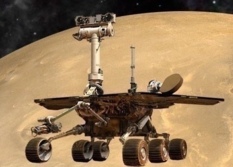A.J.S. Rayl • Feb 04, 2016
Mars Exploration Rovers Update: Opportunity Turns 12! Embarks on Electric Slide
Sols 4244–4274
Opportunity, stationed along Knudsen Ridge inside Marathon Valley at Endeavour Crater, defied the brutal cold of her seventh Martian winter in January, completing the study of an outcrop, navigating treacherous, steep slopes, and logging another productive month of exploration on the Red Planet. Along the way, something much grander happened.
On January 24th, the veteran Mars Exploration Rover (MER) wrapped the last day of her 12th year of surface operations on Mars, marking an extraordinary, historic achievement for the Mars Exploration Rovers (MER) mission.
“These milestones are in a sense arbitrary, but they do carry real significance,” reflected Steve Squyres, MER principal investigator, of Cornell University.
In the case of MER, it would not be an exaggeration to push that to ‘great significance.’ Opportunity and her twin Spirit were originally each slated to explore for 90 days and drive 600 meters. No one outside the team thought they would make it to the surface in one piece. And no one thought they would last through the first Martian winter.
While Opportunity was cruising and crater hopping across the plains of Meridiani, Spirit worked in the colder, more rugged environments of Gusev Crater. Then, during the mission’s fourth Martian winter in 2010, stuck and unable to angle herself toward the winter Sun, Spirit succumbed. Opportunity carried on, seemingly with the “spirit” of her twin onboard.
Twelve years is a long time for rovers designed and dispatched for 3-month tours...so far beyond the imagination, it’s almost unbelievable.
“Just think of some of the things that have happened back on Earth over the past 12 years,” Squyres suggested. “The entire Obama Presidency. The entire existence of Facebook. The Boston Red Sox winning the World Series three times! We've been on Mars a very long time.”
NASA and the Jet Propulsion Laboratory (JPL), home to all the agency’s Mars rovers, issued a press release. A handful of newspapers took note and offered up short features, and television newscasts here and there mentioned the MER team’s achievement in passing. But the coverage didn’t seem commensurate with the unparalleled achievement that had just taken place on Earth’s favorite other planet.
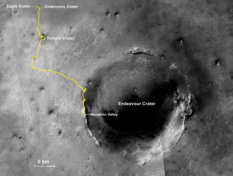
12 years of roving Mars!
The gold line on this image shows Opportunity's route from her Eagle Crater landing site to her approximate location in Marathon Valley. The base image is a mosaic of images taken by the Context Camera on the Mars Reconnaissance Orbiter. The route was provided by Larry Crumpler, of the New Mexico Museum of Natural History & Science, a MER science team member, who plays a lead role in helping chart Opportunity's course.NASA /JPL-Caltech / MSSS / NMMNHS
A monster blizzard that buried Washington D.C. and wreaked havoc in the northeast, U.S. Presidential campaigns, and other bad news stories were commanding airtime and claiming the headlines. So there were no big media splashes on Opportunity and no celebratory ice-cream-and-cake soirees heralding this intrepid, can-do veteran explorer.
When the anniversary came around and the clock struck 8:54 p.m. that Sunday night in California, most of the MER flight ops team and the mission scientists celebrated quietly, taking in the wonder of it all – along, no doubt, with past members of the team (and probably future), and the some 4000 people who contributed to getting the rovers off the ground, and the countless numbers of people around the world who have long followed this mission.
“It was a little surreal,” said Ashley Stroupe, a rover planner and driver at JPL. “It didn't quite really sink in even though I've been doing this almost since the beginning. I thought about everything we've done and accomplished, and it reminded me of what an amazing, unique, incredible thing we've got going here.”
The 12th anniversary was “subdued,” as Ray Arvidson, MER deputy principal investigator of Washington University St. Louis (WUSTL), described it. “But the rover’s still roving and we're still working,” he said.
What is truly noteworthy is that 12 years after landing, this aging robot isn’t just hanging on. Opportunity and her team are pushing the expedition ever onward into new territory and more ancient history. They’re blasting robot records with every rove and expanding our knowledge of Mars in ways no previous surface mission ever has.
“Little Miss Perfect” – as the late Jake Matijevic, a member of the original MER team, often referred to Opportunity – continues to demonstrate her MER mettle sol-in and sol-out. The mission’s geologist in the field is ascending and crossing Knudsen Ridge now to a new outcrop from which she will soon be returning more textbook informing findings.
As the veteran rover continues to push the limits of robot life, her engineers often find themselves scratching their heads. “Who would have thunk a 90-day mission could go on so long?” mused Bill Nelson, chief of MER engineering at JPL, echoing the sentiments of nearly everyone following the mission.
The fact that Opportunity is still roving is beyond remarkable, even, truth told, for those who built her.
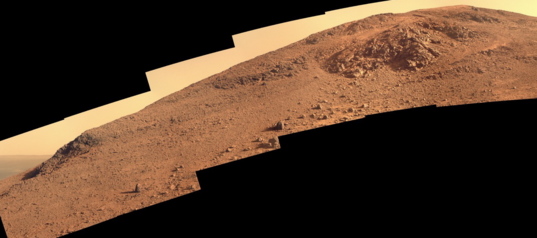
NASA / JPL-Caltech / Cornell / ASU / J. Canvin
Knudsen Ridge
Opportunity used her Pancam to take the pictures that went into this color image of Marathon Valley's southern wall. In Dec. 2015, this site was named Knudsen Ridge, after Danish astrophysicist Jens Martin Knudsen, the scientist behind the magnets on Pathfinder/Sojourner as well as Spirit and Opportunity and other spacecraft. As the rover began her 13th year of exploration, she embarked on a hike up and across this bedrocky ridge east to west (left to right in image). James Canvin, Planetary Society contributor, processed the image.It was a calm, brisk winter evening outside JPL in Pasadena, California on January 24, 2004. Dozens of news vans, satellites popping from each one, overflowed the press lot. Inside Von Karman auditorium, hundreds of journalists from around the world settled into their assigned slots, computers, recorders, and pens at the ready, eyes glued to one of the monitors.
At 8:47 p.m., Opportunity hit the Martian atmosphere and began the fiery descent, the “six minutes of terror,” as it was called, to the surface below.
The odds had been stacked against the MER team. Historically, two of three missions to Mars failed and this mission involved two robot landers, the riskiest of all planetary ventures. As has been written here many times before, no one really believed Spirit and Opportunity would land. They would be lucky to get one down on the surface. Two – impossible – so went the chatter.
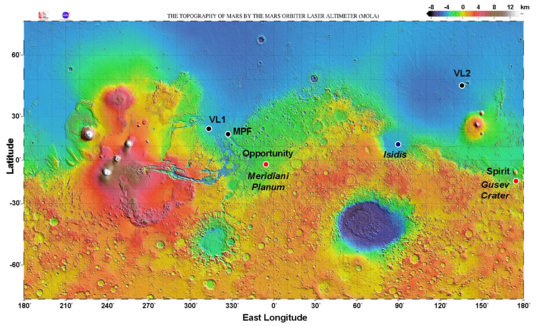
NASA / JPL-Caltech / GSFC
MER landing sites
The map above shows the two MER landing sites, as well as other mission sites. VL2 is Viking Lander 2 that landed in 1976. Gusev Crater is where Spirit landed. Meridiani Planum is where Opportunity landed. VL1 is Viking Lander 1, a stationary robot from 1976. MPF is Mars Pathfinder, a roving vehicle from 1997. Isidis was the projected landing site for the European Space Agency's Beagle 2 stationary lander that was lost on arrival at Mars in 2003.Somehow against all those odds, the Entry, Descent, and Landing team delivered Spirit to the surface three weeks earlier in what was a spectacular, breathtaking global show that drew 1.2 billion people to the NASA-JPL websites. The landing seemed to change the odds. But, when it comes to Mars, as Rob Manning, the MER system engineering manager and the EDL lead, put it: “Each one is as experimental as another.”
Just a few days into her mission, Spirit suffered a serious computer glitch that threw her into a continuous reboot loop. At first, no one knew what was happening, and in these moments, Squyres wondered – what if...?
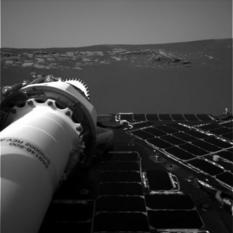
Wow!
Opportunity hit the surface of Mars at 8:54 p.m. Jan. 24, 2004 PST and by 9:05 p.m. had succeeded in scoring the first interplanetary hole-in-one, rolling to a stop inside a small crater soon dubbed Eagle. And, within hours, she sent home her first picture postcards, including the one above and awed people around the world. The in-place bedrock the scientists had hoped they might find was right there in front of the rover.NASA / JPL-Caltech
But, just like great missions and great stories go, as Opportunity was closing in on Mars, the MER team’s engineers figured it out and recovered Spirit. Now a relieved team, along with invited guests, including former Vice President Al Gore and then-California governor Arnold Schwarzenegger, and the hundreds of journalists were squarely focused on MER-B, waiting and watching the monitors and the scene emanating from MER mission control room.
At 8:54 p.m., PST, right on time, Opportunity’s spacecraft, shrouded in protective airbags, hit the surface of Mars and began bouncing. It was summer in the southern hemisphere of Mars and the rover’s first Martian day or Sol 001. The time on Mars was midday, 13:23.
Eleven minutes later, the bouncing and rolling was over. Opportunity phoned home at 9:05 p.m. PST. The energy from JPL lit the world for the second time that month.
Once the system deflated the airbags, the rover peeked out from her tetrahedron shaped capsule. She snapped some pictures, and then sent them to one of the orbiters overhead, which in turn sent them to Earth through the Deep Space Network and to servers on Earth just a few hours later.
At JPL, those first images were intercast in the wee hours of the following morning on virtually every monitor. Everywhere around the Lab people stopped and stared in awe. "I am flabbergasted, astonished, blown away!" Squyres exclaimed.
The MER science team quickly realized two things: Opportunity had rolled to a landing right inside a small crater, scoring Earth’s first interplanetary hole-in-one; and, what the scientists had come hoping to find was right there in front of the rover, along the rim of what promptly came to be known as Eagle Crater. It was the first in-place bedrock ever seen on the surface of Mars. The scientists were over the Moon, Earth’s Moon, Mars’ moons, all the moons in the solar system.
“I remember [that night] well, because of landing site predictions,” recalled Matt Golombek, the MER project scientist and science team member who has also been a Mars Exploration Program Landing Site Scientist since 2000. “Meridiani Planum was the first landing in dark terrain on Mars. The expectation was that there would be no dust and we expected a dark sandy surface with bright outcrops. I still remember one of the first images looking down the mast (it had not been deployed yet) and that is what it showed. I was about the happiest person on the team.”
Golombek might have some competition there. JPL was, without doubt, the happiest place on Earth that night. Just like the night Spirit landed, only happier. NASA, JPL, the mission – the whole world had two working rovers on Mars. The MER team had achieved the impossible.
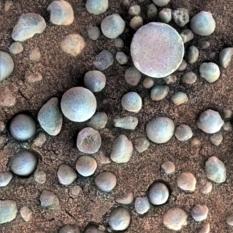
Martian blueberries
The small spherules on the Martian surface in this close-up image are near Fram Crater, which Opportunity visited Opportunity in April 2004. Nicknamed "blueberries," these spherules turned out to be hematite-rich concretions that provide evidence of an ancient watery environment. The area shown is 3 centimeters (1.2 inches) across. The view comes from the Microscopic Imager on Opportunity's robotic arm, with color information added from the rover's Panoramic Camera.NASA / JPL-Caltech / Cornell / USGS
For many of the original MERsters, that landing day still reigns supreme as favorite mission moments go. “It's like the birth of your child,” said John Callas, MER project manager at JPL, who actually spent many nights tending to the robot twins while they were in their incubation stage during development.
Opportunity studied that bedrock in Eagle Crater. She found the hematite the scientists knew was there from orbital data, in curious spherules, tiny slate blue concretions that the scientists dubbed ‘blueberries, embedded in outcrop rocks and scattered all over the place. Since hematite with the crystalline grain size indicated in the Martian spherules usually forms in a wet environment on Earth, the scientists concluded that the hematite concretions are evidence of past water.
The rover had sent home enough mineralogical data from inside the crater within the first 60 sols or Martian days of her mission for the scientists to hypothesize that there was once some kind of ancient wet environment there. Then, after nearly two months of study inside Eagle Crater, Opportunity roved out and onto "the shoreline of what was once a salty sea suitable for life," the MER scientists announced at a special press conference held at NASA headquarters in Washington D.C., in late March 2004. "This was a habitable environment on Mars...a shallow sea...very suitable for life," said Squyres then.
From Eagle Crater, Opportunity struck out on a journey across the plains of Meridiani. She took a jaunt to inspect her own heat shield jettisoned during landing. She discovered meteorites scattered here and there, went crater hopping and uncovered older layers of bedrock that took the mission further back in Martian time. And she drove into a crater called Endurance; marking the first time a robot rover had ever done such a thing.
Toward the end of September 2006, after more than 9.2 kilometers (5.7 miles) and 21 months of driving, mostly across the seemingly endless, flat plain, pocked with smaller craters and strewn with sand ripples, Opportunity roved up to the rim of Victoria Crater. It was 730-meters (0.45-mile) in diameter, nearly eight times the size of Endurance Crater.
The robot spent two years at Victoria. She drove into it and studied the stratigraphy or layered bedrock exposed inside just like a human field geologist would do. Then, in 2008, Squyres announced that Opportunity had a new destination: Endeavour Crater.
A giant hole in the ground to the southeast, Endeavour Crater is 22-kilometers (13.7-miles) in diameter and 300 meters (984 feet) deep, more than 20 times larger than Victoria, and, as Squyres said then, “staggeringly large compared to anything we've seen before."
No one knew if Opportunity could make it to Endeavour. Consider that Victoria Crater had been a dream destination. Endeavour seemed, by many opines, a pipedream. It was, after all, as far away as the rover had already driven on the entire mission at that point. "We may not get there," Squyres admitted during his 2008 announcement. "But it is scientifically the right direction to go."

NASA / JPL-Caltech / Cornell
At Victoria Crater
This image of Opportunity on the rim of Victoria Crater was produced using "Virtual Presence in Space" technology, developed at JPL. This technology combines visualization and image processing tools with Hollywood-style special effects. Created with a photorealistic model of the rover and an approximately full-color mosaic of the location, Cape Verde, it offers a sense of scale. The rover worked in and around this 730-meter (0.45-mile) diameter crater for two years.By directing the rover southward, the MER scientists expected to find younger rock layers on the surface and older cobbles that may have come from craters larger and deeper than Victoria. The team’s ‘sixth scientific sense’ was right on.
In 2009, as Opportunity was en route to the big crater, the Compact Reconnaissance Imaging Spectrometer for Mars (CRISM) – a visible-infrared spectrometer onboard the Mars Reconnaissance Orbiter (MRO) that searches for mineralogical evidence of past and present water – picked up the signatures for phyllosilicates along Endeavour Crater’s western rim.
Phyllosilicates, specifically the type of clay minerals called smectites that CRISM detected, are evidence of the kind of near-neutral water the MER mission had hoped to find. While Spirit sent home evidence for near neutral or pure water in a rock called Comanche at Husband Hill, the twin MERs mostly found evidence for past environments with highly acidic or salty water.
The CRISM data detected signatures of smectites at a couple of accessible locations along Endeavour’s western rim, at Cape York, and Marathon Valley, where the instrument indicated there was a mother lode of the clay mineral remnants just waiting for Opportunity. It was a big deal. A past near-neutral water environment that fostered the formation of clays would have been, using Earth as comparison, a likely natural habitat for the emergence of life.
After driving for nearly three years and 21.5 kilometers (13.35 miles), Opportunity, in August 2011, pulled into the rim of Endeavour Crater. The robot field geologist wasted no time in beginning the first up-close investigation of a Noachian Period crater, a site that promised to take the MER team and everyone following the mission further back in Martian geological time than any other ground mission, to the time 3 to 4 billion years ago when most planetary scientists believe Mars was more like Earth.
The robot’s work at Cape York, and specifically on Matijevic Hill there, enabled the mission to be the first to ground-truth phyllosilicates on Mars. They found the smectites in an unusual coating on a layer or strata of bedrock now known as Whitewater Lake. It’s the oldest Martian terrain uncovered to date.
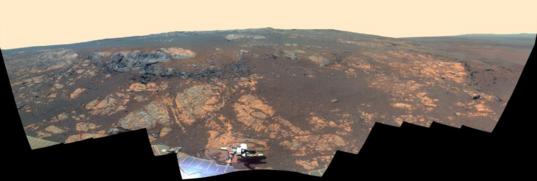
NASA / JPL-Caltech / Cornell
Matijevic Hill
Opportunity took the pictures that went into this panorama in November and December 2012. Orbital observations indicate the presence of clay minerals on this hill, part of Cape York on the western rim of Endeavour Crater. The rover found the evidence for those clay minerals, a sure sign of water Earthlings know and love, and MER became the first mission to ground-truth phyllosilicates on Mars. The team named the site shorting after the sudden passing of Jake Matijevic, one of the original MER team and one of the mission's chiefs of rover engineering. "We wouldn't have gotten to this place eight-and-a-half years after Opportunity's landing without Jake Matijevic," said MER P.I. Steve Squyres.At her current winter haven on Knudsen Ridge, Opportunity and her team are looking now to home in on the remnant evidence of various kinds of ancient clay minerals that CRISM has detected. More mineralogical evidence from Marathon Valley, home of the “mother lode” of smectites, will enable the MER scientists to better describe the watery environment that once was there at Endeavour and, perhaps, reveal more about just how much Mars may have once been like Earth. For now, it’s history still in the making.
Although the team is using a fairly precise mineral map that Arvidson, who is a co-investigator on CRISM, and his team at WUSTL created based on additional CRISM data, and even though the data shows the signature all around Marathon Valley, the carriers of the smectite remnants aren’t immediately obvious.
Not long after Opportunity drove into Marathon Valley last July, the rover and her team quickly zeroed in on intriguing deep, deep red rocks and features that are distinctively different from the normal tan red Martian outcrops. Turns out, what the scientists call “red zones” correlate one-to-one with the CRISM mineral map the team is using. The work, however, is ongoing and the scientists have yet to make any announcements.
"Our hypothesis is that the deep red rocks are carrying the smectite signatures,” said Arvidson. “But we wanted to get the baseline for the ‘normal’ [tan red] rocks here on Knudsen Ridge.”
That’s what Opportunity was doing when January dawned at Endeavour. From a north-facing slope on Knudsen Ridge, the rover was hunkered down over Private John Potts, named for a member of the Lewis and Clark Expedition, and in the midst of a scientific study of the tan red bedrock.
The robot had successfully brushed a chosen surface spot with her Rock Abrasion Tool (RAT), checked it out with the routine close-up Microscopic Imager (MI) pictures and chemical measurements with the Alpha Particle X-ray Spectrometer (APXS). On Sol 4244 (January 1, 2016), Opportunity deployed her RAT again, this time to grind 1 millimeter into the chosen spot.
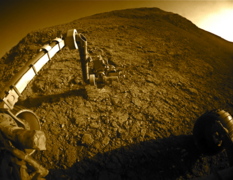
Digging Pvt. Potts
Opportunity used her Front Hazard Camera (Hazcam) to take this raw image of the tanred outcrop Pvt. John Potts, named for a member of the Lewis & Clark Expedition, on Jan. 5, 2016. This camera is mounted low on the rover and has a wide-angle lens. The robot spent much of January 2016 studying the bedrock. Now, she is in the midst of a trek up and across Knudsen Ridge.NASA / JPL-Caltech
During the next couple of sols, the rover conducted the in-depth analyses on the abraded surface spot with her MI and APXS, and then spent the rest of the week taking Panoramic Camera (Pancam) pictures of Knudsen Ridge that will be stitched together into one of the mission’s hallmark oversize panoramas.
Opportunity ground another millimeter into the target spot on Pvt. Potts again during the second week of January, and then brushed the target on Sol 4259 (January 16, 2016) to sweep away the grind tailings. The robot then conducted the usual MI and APXS "looks" inside the ground target and took more color Pancam images of Knudsen Ridge.
“It took a few sols to pull [the RAT] off, because of power limitations in the Martian winter, ”said Gale Paulsen, Senior Systems Engineer & Deputy Director at Honeybee Robotics and Spacecraft Mechanism Corporation, who oversees the RAT. Nevertheless, he reported: “The grind and brush went great and the RAT is still healthy.”
Having looked at and examined the chemical composition of the undisturbed surface, the brushed surface, and ground down surface of the Pvt. Potts outcrop, the rover’s study was complete. It wasn’t surprising to the scientists that there was no surprise in the data. “It looks like normal Shoemaker breccia material,” said Arvidson. Just like they expected and just like so many rocks Opportunity has found around craters.
The rover then bumped 5 centimeters (2 inches) on Sol 4262 (January 19, 2016) to position herself in front of Private John Collins, a patch of soil or coarse, dark grains. “It’s a really interesting, dark gray sand deposit, a couple centimeters wide, that is kind of running downhill,” said Arvidson. “It seems to be a little bit of an oddity, and we're just wondering what it's doing there.”
On Sol 4263 (January 20, 2016), Opportunity began several sols of MI and APXS investigations of the target. During the Martian winter, illumination for the MI is at a very low angle, so there's a lot of contrast and in that contrast the scientists noticed that Pvt. Collins has a little ridge in the middle, and an interesting, pitted texture on the surface. “We're not exactly what sure causes the pits, but it's just a pile of normal windblown dark basaltic sand, as seen from the spectra from Pancam and as seen from the APXS,” said Arvidson. “So there's nothing in the composition that's odd.”
Opportunity spent much of the third week of January and into the fourth week attending to routine engineering business, like adjusting her attitude [physical, not psychological], and taking more Pancam and Navigation Camera (Navcam) images, as she finished up her in-depth study of Pvt. Collins.
By the end of Sol 4267 (January 24, 2016), the robot field geologist’s work at this site was done. So, for the rover, was another year. [Technically, Opportunity wrapped her year in her sleep since the anniversary time of 8:54 p.m., PST, was 06:54 local Mars time and the rover normally wakes at 9 a.m. or later.] After a full sol’s work in the depths of winter on her anniversary though, the rover that loves to rove had effectively put a “bow” on her 12th Earth year of surface operations.
Mars, it must be noted, has “cooperated,” as the MER team is wont to say, except for that nasty, planet-circling dust storm in 2007 that nearly smothered Opportunity. Yet, Spirit and Opportunity turned out to be engineering marvels that have amazed the world, robot heroes that have and are taking Earthlings on the first overland expedition of Mars.
“It's been an adventure,” said Squyres. “Above all, it's testimony to the work that was done by the remarkable team that built Spirit and Opportunity so many years ago.”
Indeed. Still, Opportunity has roved for so long, has been “Little Miss Perfect” for so many years, so many miles, that she’s astonished even the members of even that “remarkable team” that built her and safely delivered her to the surface.
"While Opportunity is a bit worse for wear, I have to admit that once again our ability to understand the lifetime of our own designs is really poor,” said Manning. “With their rather constant temperature environment and with fewer moving parts, it makes some sense to me that the Voyager spacecraft would live for decades. It is harder for me to believe that a highly mechanical, solar powered Mars rover that must suffer rather impressive daily and yearly temperature extremes and dust storms would be capable of lasting more than a few years,” he said.
Of course, the engineers at JPL “work hard” to build spacecraft that are as reliable as possible, but without years of testing, they really don't know whether what they build is “reliable enough,” said Manning, currently the chief engineer for the Low-Density Supersonic Decelerator. And, MER had only three years to go from single power point presentation to Cape Canaveral. “One tiny goof in our rover design can make the difference between a 12-year lifetime and a one-month lifetime,” he noted. “Apparently, we goofed when we said that the rovers wouldn't last much longer than a few months. I guess you can say that was the right kind of goof."
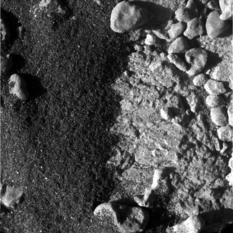
Pvt. Collins up close
After finishing her study of Pvt. Potts, a "normal" Martian rock, as Deputy P.I. Ray Arvidson described it, Opportunity used her Microscopic Imager (MI) to take this raw picture of Pvt. John Collins, weird patch of dark grey sand that features a little ridge and pits. "We not exactly what sure causes the pits, but it's just a pile of normal windblown basaltic sand," said Deputy P.I. Ray Arvidson on looking at the rover's findings.NASA / JPL-Caltech / Cornell / USGS
The right kind of “goof” and a hugely critical factor to be sure. Yet there’s still more to the MER mission’s success and longevity.
It takes a diehard dedicated team of people ready, willing, and able to be on their toes day or night to do all it takes to care and tend a robot tens of millions of miles away on a cold harsh planet … including coming up with work-around solutions to problems no one could have imagined much less anticipated. So, while the external fanfare about this historic achievement may have not been what it seems like it should have been, the MER team is and always has been driven by other things.
Back in the beginning, Squyres and JPL’s Pete Theisinger, the first MER project manager (now the director of the Engineering and Science Directorate at JPL) instituted tried and true principles – respect, equality, courage and commitment, collaboration, honor, loyalty, and, perhaps most significantly, gratitude – in the structure and day-to-day operations of the mission. It may sound old-fashioned in this cutthroat world where “sharp elbows” are, increasingly, rewarded.
However, those principles, and the fact that MER team members signed up to them, perhaps the most magical factor of all, wound up forging a bonded team of scientists and engineers that remains as devoted to the rover and the mission today as in 2004, something that was evident in the appreciative anniversary email Callas sent out to his team:
“You, who conceived, built and operate this fine machine, have seized this chance to unlock the secrets of the Red Planet,” he wrote. “All of you deserve this recognition for what you have done, advanced our understanding of this sister world...”
For 12 years, the MER ops team has gone to work on Mars almost every day and confronted mind-bending challenges, one after another. But those tried and true principles seemed to empower team members, and on that foundation, they blazed a trail that continues to define a new kind of human exploration on other planets. Along with stellar engineering and Mars’ cooperation, that is why Opportunity is still roving.
And as the rover rolls, so too does time. With the 12 year anniversary behind her, Opportunity woke up and took some final documentary imagery of Pvt. Collins and Pvt. Potts on Sol 4268 (January 25, 2016), then got a good night’s sleep in preparation for her hike across Knudsen Ridge. It would be the start of what Arvidson has dubbed the “electric slide,” roving up and west across the steep slopes of the ridge, toward a deep red outcrop the scientists chose as the next attraction, an outcrop where the residual minerals from smectite clays are likely waiting.
“We decided that with the baseline composition from Pvt. Potts, and having looked at Pvt. Collins, it was time to get to a bigger outcrop where there's more deep red stuff exposed,” said Arvidson. “And this one shows lot of structure, stratigraphy and a lot of red zones.”
The driving was intense, but Opportunity managed to put 4.99 meters (16.37 feet) in the rear view mirror on Sol 4269 (January 26, 2016), and then drove another 4.43 meters (14.53 feet) on the following sol. It would be the rover’s final drive in January, putting her odometer at 42.65 kilometers (26.50 miles).
“It’s been very tricky,” said Stroupe. “We've been doing small drives and pulling out all our tough terrain tricks – checking our slip at each step, steering the wheels one at a time to make sure we don't start sliding down the hill, watching the wheel currents, everything.”
The terrain does offer Opportunity a decent “grip,” better than almost any other type of terrain, according to Stroupe. “It's not smooth pavement and not loose fluffy soil, but rugged rock, and so the rover’s wheels can hold onto, grip onto the terrain and that's helped us a lot,” she said.
The steepness of Knudsen Ridge, that’s another thing. “We are right at the limit of what we have driven or climbed as far as slopes,” said Nelson.
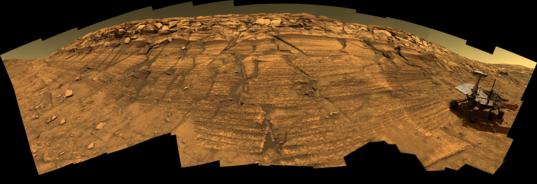
NASA / JPL-Caltech / Cornell
Endurance slopes
Opportunity is now driving on steep 25-to-30-degree slopes she hasn't seen since Endurance Crater back during her first year of exploration in 2004. This image of the rover inside Endurance Crater was produced using JPL's "Virtual Presence in Space" technology. It features a photorealistic model of the rover and an approximately full-color mosaic of Burns Cliff, named for the late mineralogist Roger Burns of MIT. The size of the rover in the image is approximately correct. Rover model by Dan Maas, synthetic image by Zareh Gorjian, Koji Kuramura, Mike Stetson and Eric M. De Jong.In fact, on her final drive of the month, Opportunity hit a tilt of 30.6 degrees. “That’s a tilt higher than any we’ve seen in more than 4000 sols, since we had to stop a drive back in Endurance Crater when we hit a tilt of slightly over 31,” said Stroupe. “We saw something in that ballpark with Spirit during that last winter she survived, but we were parked on the edge of Home Plate, and not trying to maneuver or drive around.”
Tenacious terrain notwithstanding, Opportunity has been “climbing like a mountain goat,” said Nelson.
“We've been getting less slip than we thought we would, so we haven't had to correct as much, and we've stayed on course,” elaborated Stroupe. “We've had a lot of experience now doing this kind of stuff and know how to do it right and minimize the risks. Of course,” she added, “the next drive could be totally different.”
On the power front, Opportunity’s energy continues to be better now than original predictions. The robot began the month producing around 450 watt-hours of solar power, nearly half her full capability (with clean solar arrays). The dust factor on her solar arrays had improved slightly to 0.658, meaning the robot was utilizing more than 65% of the sunlight hitting her arrays. The sky overhead was relatively clear with atmospheric opacity or Tau measured at 0.414. By month’s end, the solar powered rover was producing upwards of 490 watt-hours with an array dust factor of 0.691, under a slightly hazy winter sky.
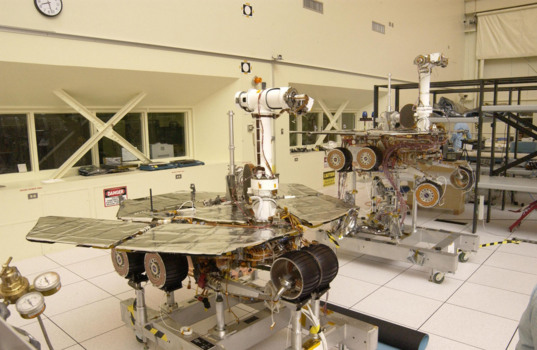
NASA / JPL-Caltech
An amazing journey continues
In a "clean room" at JPL, the twin rovers, Spirit and Opportunity, sat side-by-side in different stages of development in 2003. Since then, Spirit went on to climb a mountain, take pictures of Mars' notorious dust devils, and sent home the mission's first evidence for near-neutral water. Opportunity was first to, and so far only, robot to finish a marathon on another planet, rove into a crater, and ground-truth the presence of phyllosilicates on Mars, a sure sign of near neutral water – and she is exploring still.Although power levels are better than the original predictions, better than most previous winters, and basically are really good power levels considering it is winter on Mars, the rover is still power challenged because it’s just so cold, even near the equator where Opportunity is based. And when it’s really cold, Martian cold, the rover’s battery does not charge up as efficiently. “That becomes more understandable when you realize that a battery is basically a chemical system and chemical activity is temperature sensitive,” Nelson pointed out.
It’s not stopping this rover. The Martian spring is just a few months away, the outlook is bright, and Opportunity is pressing ever onward, seemingly with as much determination and resolve as this robot has always exhibited. “We're past the darkest time of the winter, so things should be getting better, easier from here on,” said Callas.
Mars seems to be all in favor, “cooperating” by sending in wind gusts in recent weeks that have cleared some accumulated dust from the solar powered robot’s array and helped boost energy. “Our rover is doing fantastically well,” summed up Nelson at month’s end.
As January turned to February, Opportunity was working away and “the amazing, unique, incredible thing” called MER was guiding her into the mission’s 13th year.
“I continue to be amazed,” said Manning.
Spirit Remains Silent at Troy
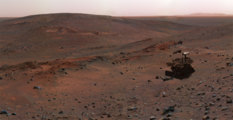
Spirit on Husband Hill
This image of Spirit on the flank of Husband Hill, named for Rick Husband, commander of the Space Shuttle Columbia's final, tragic mission, is another one produced using JPL's "Virtual Presence in Space" technology. The size of the rover in the image is approximately correct and was based on the size of the rover tracks in the mosaic.NASA / JPL-Caltech / Cornell
Stuck in the sandy edge of a shallow hidden crater along one side of Home Plate, Spirit phoned home on Sol 2210 (March 22, 2010). It would be the last communiqué.
Spirit worked for more than six Earth years and drove 7,730.50 meters (4.80 miles) in some of the harshest Martian terrain the mission will ever encounter.
She was the first rover to climb a mountain, the first robot to take pictures of dust devils on the surface of Mars, and the first to find evidence for near-neutral water on Mars. In those 6+ years, the robot that came to known as the-little-rover-that-could literally defined MER mettle.
More than 1,300 commands were radiated to the rover as part of the recovery effort to elicit a response. NASA concluded recovery efforts on May 25, 2011.
The remaining, pre-sequenced ultra-high frequency (UHF) relay passes scheduled with the Odyssey orbiter completed June 8, 2011.
No Earthling has heard from Spirit since.
Let’s Go Beyond The Horizon
Every success in space exploration is the result of the community of space enthusiasts, like you, who believe it is important. You can help usher in the next great era of space exploration with your gift today.
Donate Today

 Explore Worlds
Explore Worlds Find Life
Find Life Defend Earth
Defend Earth


